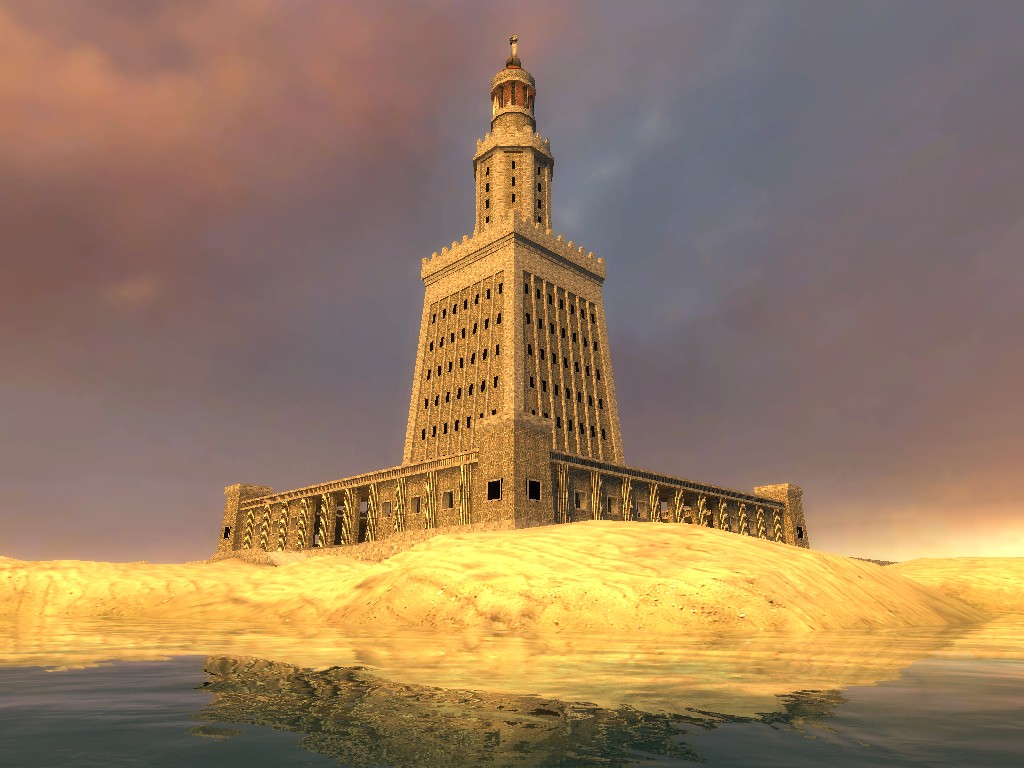The Seven Wonders of the Ancient World: Lighthouse of Alexandria (Egypt)
Illuminating the Seas: The Lighthouse of Alexandria

Introduction
The Lighthouse of Alexandria, also known as the Pharos of Alexandria, stood as a beacon of enlightenment and marvel in the ancient world. Constructed on the island of Pharos off the coast of Alexandria, Egypt, this monumental lighthouse guided sailors and merchants through the treacherous waters of the Mediterranean Sea.
This article explores the history, architecture, and enduring legacy of one of the Seven Wonders of the Ancient World.
Historical Context
Commissioned by Ptolemy I Soter, one of Alexander the Great's generals, and constructed around 280 BCE, the Lighthouse of Alexandria was a testament to the engineering and architectural prowess of ancient Egypt.
Designed to aid maritime navigation and facilitate trade, the lighthouse quickly became a symbol of Alexandria's prosperity and importance as a cosmopolitan centre of culture and commerce.
Architectural Marvel
Rising over 100 meters (330 feet) in height, the Lighthouse of Alexandria was among the tallest man-made structures of its time. Its design, attributed to the Greek architect Sostratus of Cnidus, featured three tiers: a square base, a cylindrical middle section, and a tapered tower crowned by a statue of the god Zeus or possibly Poseidon.
Constructed primarily of limestone blocks and marble, the lighthouse gleamed in the sunlight, serving as a visible landmark for ships approaching the bustling port of Alexandria.
Navigational Aid and Symbol of Prosperity
The Lighthouse of Alexandria was equipped with a sophisticated system of mirrors and fire beacons that emitted a brilliant light visible from great distances.
This illumination not only guided ships safely into the harbour but also symbolized the intellectual and cultural enlightenment associated with Alexandria, home to the legendary Library of Alexandria and the renowned scholars of the ancient world.
Legacy and Demise
For centuries, the Lighthouse of Alexandria stood as a marvel of human ingenuity and a symbol of Alexandria's greatness. However, its fate was sealed by a series of earthquakes in the 14th century CE, which caused significant damage to the structure.
Over time, the lighthouse fell into disrepair, and its ruins were gradually submerged by the waters of the Mediterranean.
Conclusion
Though lost to the sands of time and the depths of the sea, the Lighthouse of Alexandria continues to captivate the imagination and inspire wonder. As a testament to the achievements of ancient civilizations and the enduring quest for knowledge and enlightenment, the lighthouse serves as a beacon of inspiration for generations to come.
Its legacy lives on in the annals of history and the collective memory of humanity, illuminating the seas and guiding the way toward a brighter future.
References
- McKenzie, Judith (2011). The Architecture of Alexandria and Egypt: 300 BC – AD 700. Yale University Press. p. 42. ISBN 978-0300170948.
- Clayton, Peter A. (2013). "Chapter 7: The Pharos at Alexandria". In Peter A. Clayton; Martin J. Price (eds.). The Seven Wonders of the Ancient World. London: Routledge. p. 11. ISBN 9781135629281.
- Clayton, Peter A. (2013). "Chapter 7: The Pharos at Alexandria". In Peter A. Clayton; Martin J. Price (eds.). The Seven Wonders of the Ancient World. London: Routledge. p. 147. ISBN 9781135629281.
- "Treasures of the Sunken City". Nova. Season 24. Episode 14. November 18, 1997. PBS. Transcript. Retrieved March 5, 2012.
- "Sunken Ruins of Alexandria Will Be World's First Underwater Museum". Earthables. Archived from the original on March 10, 2016. Retrieved March 27, 2016.
- Smith, Sir William (1952). Everyman's Smaller Classical Dictionary. J. M. Dent & Sons Ltd. p. 222.
- Haag, Michael (2008). Vintage Alexandria: Photographs of the City, 1860–1960. American University in Cairo Press. p. 113. ISBN 9789774161926.
- Over twenty-three tons of silver. "This was an enormous sum, a tenth of the treasury when Ptolemy I assumed the throne. (In comparison, the Parthenon is estimated to have cost at least 469 talents of silver.)"[1]
- Cartwright, Mark. "Lighthouse of Alexandria". World History Encyclopedia. Retrieved November 10, 2020.
- Tomlinson, Richard Allan (1992). From Mycenae to Constantinople: the evolution of the ancient city. Routledge. pp. 104–105. ISBN 978-0-415-05998-5.
- Mckenzie, Judith (2007). Architecture of Alexandria and Egypt 300 B.C. A.D 700. Yale University Press. p. 41. ISBN 978-0-300-11555-0.








































